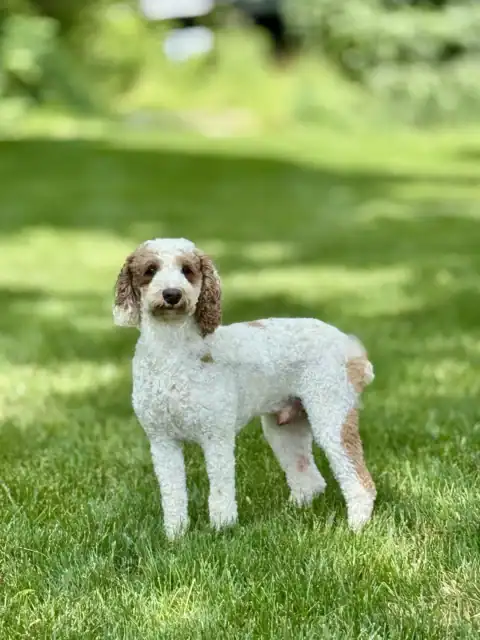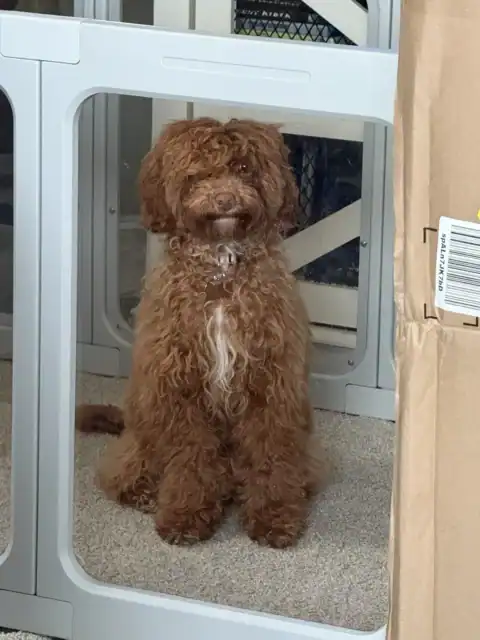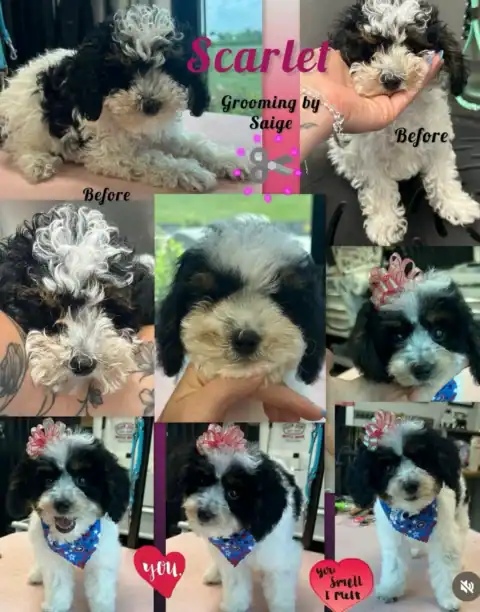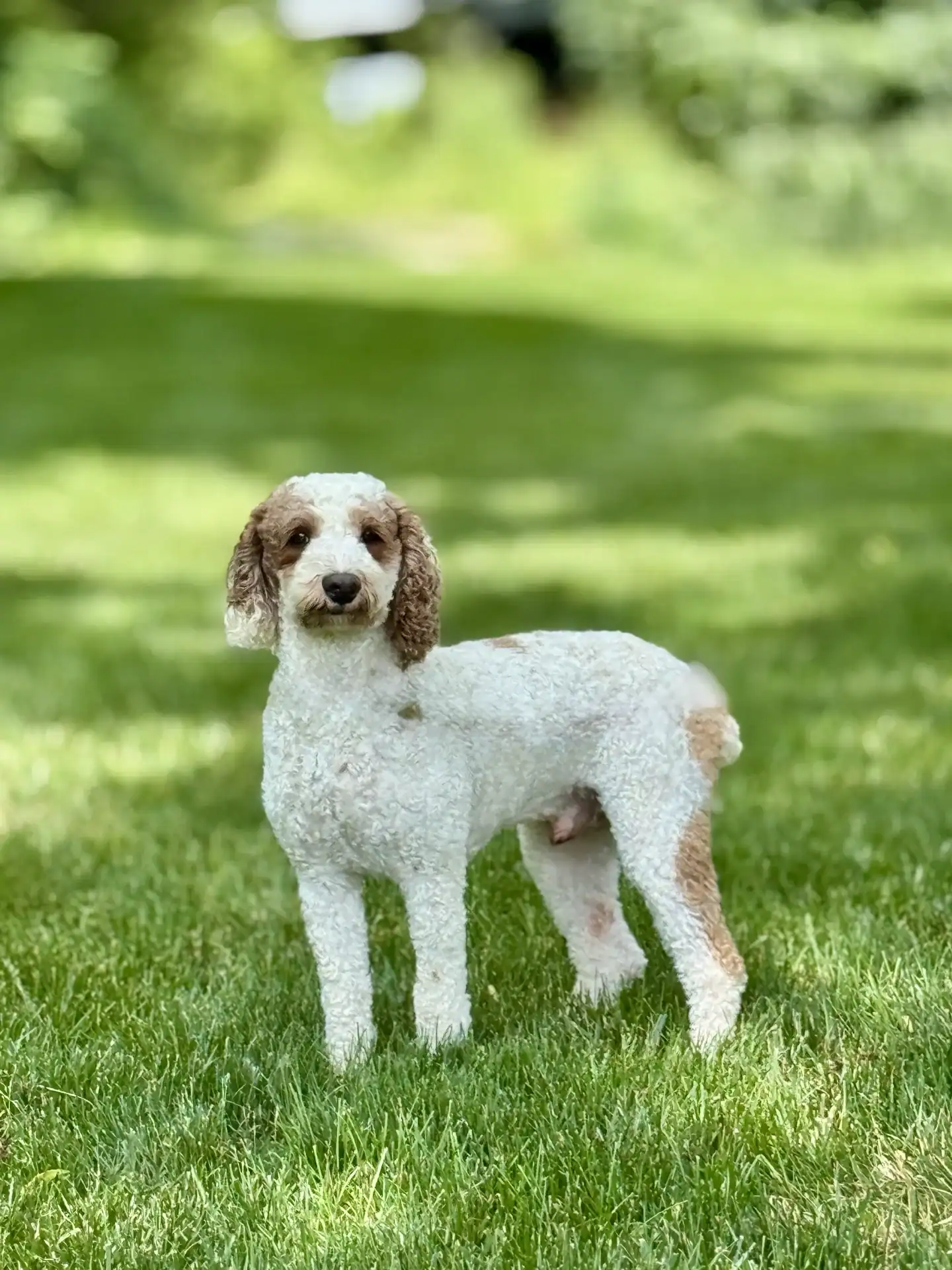Most people think picking the smaller dog means a lower-maintenance pet, but when it comes to poodles and goldendoodles, they are more similar than you think.
As a breeder with over a decade of experience helping families choose between Mini Goldendoodles and Toy Poodles, I’ve developed expertise in matching the right dog to each family’s needs. Though I work with fewer poodle varieties these days, my best advice is to visit in person. This allows you to see which puppy naturally connects with your family, making it easier to choose the perfect companion for your home.

Temperament and personality
People often ask me: “Is the toy poodle or Mini Goldendoodle a better fit for young kids and other pets?” In my experience, both breeds do great with little ones. If you’ve got a houseful of toddlers, neither breed is going to be a problem. They’re both gentle, love people, and enjoy being part of a busy family.
The biggest personality difference I see is energy level and barking. Toy poodles tend to be more energetic and a bit more vocal, while Mini Goldendoodles are usually a touch calmer and a bit quieter. It’s not a hard-and-fast rule every dog is unique, but I notice it more often than not.
If you’re looking at different generations of goldendoodles, like F1, F1b, or multi-gen: the more poodle in the mix (like F1b), the more energetic the dog can be. Still, the parents’ personalities matter most.

Grooming and maintenance
Grooming is where people usually get thrown off. Toy poodles always have a curly coat. That classic poodle curl looks adorable, but it takes work. You’ll need to brush regularly and plan on trips to the groomer.
Mini Goldendoodles, though, can have straight, wavy, or curly coats. Wavy or straight-coated Mini Goldendoodles are typically lower maintenance than a curly poodle. If you’re a first-time dog owner and worried about the amount of brushing and upkeep, a straight-coated Mini Goldendoodle is probably the easiest of the bunch.
Don’t assume the smaller dog (toy poodle) will need less grooming—those little poodles can actually demand more coat care than a wavy Mini Goldendoodle.

Hypoallergenic qualities
All poodles are about as hypoallergenic as you can get. If allergies are a concern, they’re a safe bet. Mini Goldendoodles can be almost as hypoallergenic, especially the F1b and multi-gen lines with lots of poodle ancestry. If you really need a low-allergen pup, that’s something to talk to the breeder about and factor in when picking your puppy.
Training and intelligence
Both the toy poodle and Mini Goldendoodle are smart—and want to please you. Training either one is usually a breeze. I don’t see a real difference in how quickly they pick up new tricks or house manners. The key is being consistent and patient, especially when you’ve got young boys in the house who want to “help.”
Family fit and lifestyle
To be honest, both breeds work with just about any family—especially those with kids. This is where it comes down to personal preference: Do you want an even smaller dog with a little more energy (toy poodle)? Or a slightly larger dog that might be a little more relaxed (Mini Goldendoodle)? Either way, if your family is ready for responsibility and love, you can’t go wrong.

Exercise needs
Both breeds need a fair bit of exercise to stay happy (and calm in the house). Toy poodles often have a bit more energy and will benefit from more walk time or play in a fenced yard. For a Mini Goldendoodle, two walks a day or some solid play yard time does the trick. A toy poodle might need three walks or an extra half hour of running off energy.
Common health issues
From my years raising these breeds, there aren’t huge, consistent differences in health. Both are generally healthy with good breeding.
One thing to note: toy poodles are known for bad teeth, and honestly, the smaller they are, the worse it sometimes gets. Even at three or four years old, I’ve had tiny poodles that needed multiple teeth pulled. If you’re not ready to stay on top of brushing and regular dental cleanings, this is something to consider.
Size and appearance
Toy poodles max out around 12 pounds (anything over that, and they’re technically “mini” poodles). Mini Goldendoodles, on the other hand, typically end up between 25 and 45 pounds—so they’re a noticeably bigger “small” dog.
As for looks, both breeds come in a bunch of coat colors and patterns. The variety mainly comes down to the parents, so check with the breeder if you have a preference.
Common misconceptions
The biggest myth I see: people assume a smaller dog equals lower maintenance. With toy poodles, that’s just not true. Their tiny mouths can mean more dental bills, and curls take work.
Another thing folks miss: toy poodles will always have a curly coat, which needs more regular brushing. A Mini Goldendoodle with a wavy or straight coat is far less demanding to keep looking nice.

In closing
Don’t pick based on size alone. Take into account energy level, grooming needs, and your willingness to deal with possible dental issues. And remember—sometimes, meeting the puppies is the only way to really know which one is the perfect fit for your family.

